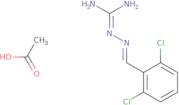Informations sur le produit
- ((2,6-Dichlorobenzylidene)amino)guanidine acetate
- ((2,6-Dichlorobenzylidene)amino)guanidine monoacetate
- 1-(2,6-Dichlorobenzylideneamino)guanidine acetate
- 3-((2,6-Dichlorophenyl)methylene)carbazamidine monoacetate
- Br 750
- Guanabenz acetate [USAN:JAN]
- Guanabenz monoacetate
- Guanidine, ((2,6-dichlorobenzylidene)amino)-, monoacetate
- Hsdb 6535
- Hydrazinecarboximidamide, 2-((2,6-dichlorophenyl)methylene)-, monoacetate
- Voir d'autres synonymes
- Hydrazinecarboximidamide, 2-[(2,6-dichlorophenyl)methylene]-, acetate (1:1)
- N''-[(1E)-(2,6-dichlorophenyl)methylidene]carbonohydrazonic diamide acetate
- N''-[(1Z)-(2,6-dichlorophenyl)methylidene]carbonohydrazonic diamide acetate
- N''-[(2,6-dichlorophenyl)methylidene]carbonohydrazonic diamide acetate
- Rexitene
- Tenelid
- Unii-443O19Gk1A
- WY 8678 acetate
- Wytens
- Wytensin
Guanabenz acetate is a pentobarbital drug that is used in the treatment of congestive heart failure. It has been shown to increase the glomerular filtration rate and decrease the level of plasma proteins, such as gamma-aminobutyric acid and sodium succinate. It also inhibits the uptake of fatty acids by liver cells. Guanabenz acetate has been shown to be effective in vivo treatment for autoimmune diseases, infectious diseases, and other conditions. This drug can be given orally without any absorption enhancer or polymer, which makes it an attractive alternative to pentobarbital sodium.





